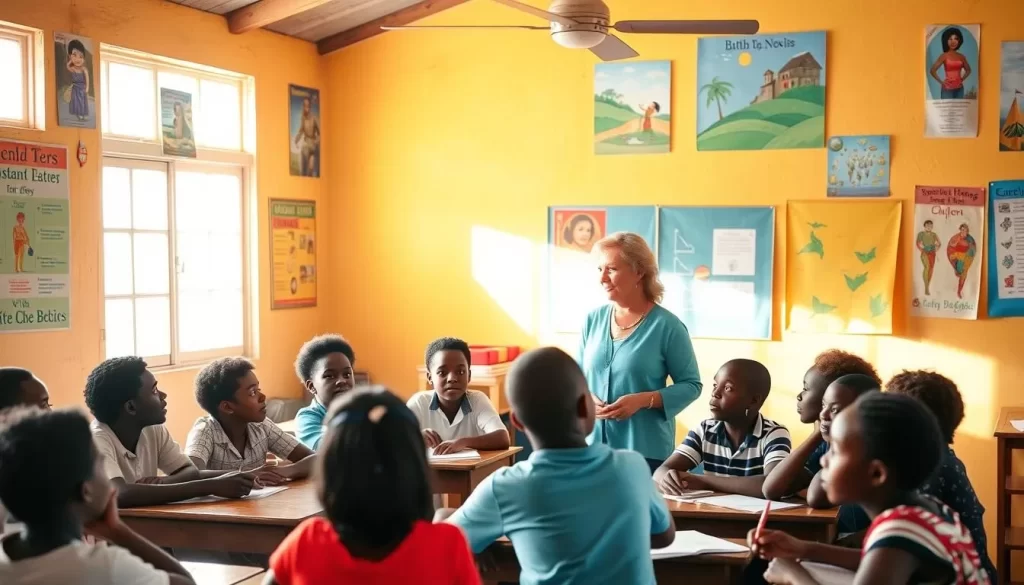When you visit the twin-island nation of Kitts & Nevis, you’ll quickly notice that English is the primary language spoken. This is a direct result of the country’s colonial history, which shaped its cultural and governmental systems. As the official language, English plays a vital role in education, governance, and tourism, making communication seamless for visitors and locals alike.
With a literacy rate of over 98%, the prominence of English reflects the nation’s commitment to education and development. However, the islands’ linguistic heritage goes beyond English. Many residents also speak Kittitian Creole, a vibrant dialect that adds depth to the country’s cultural identity. While not an official language, it is widely used in everyday conversations, especially in rural areas.
Exploring the language spoken in Kitts & Nevis offers a glimpse into the nation’s rich past and its evolving present. Whether you’re engaging with locals or navigating the islands, understanding this linguistic landscape will enrich your experience in this beautiful country.
Exploring the Island’s Linguistic Heritage
Centuries of colonial rule and diverse communities have shaped the language spoken here. The islands’ linguistic heritage is a fascinating blend of influences, from British colonialism to African and indigenous roots. This unique mix has created a vibrant linguistic landscape that reflects the history and culture of the country.

The Legacy of British Colonial Influence
British colonial rule, which began in the 17th century, left a lasting imprint on the islands. English became the dominant language, used in governance, education, and trade. This influence is still evident today, as English remains the official language of the island nation.
During the colonial era, the population adapted English to their needs, blending it with African and indigenous elements. This process gave rise to unique dialects and expressions that continue to thrive in local communities.
Diverse Communities and Their Impact
The islands’ linguistic heritage is also shaped by their diverse communities. African, Afro-European, and East Indian groups have all contributed to the rich tapestry of language spoken here. These influences are particularly evident in local creole dialects, which add depth and character to everyday communication.
Today, the interplay between English and creole expressions creates a dynamic linguistic environment. This blend of cultures not only reflects the islands’ history but also strengthens the sense of community among its people.
St. Kitts & Nevis: Official and widely spoken languages
The linguistic landscape of this Caribbean nation is shaped by its colonial past and vibrant culture. English serves as the official language, playing a central role in governance, education, and media. This ensures seamless communication across the island nation, making it accessible for both locals and visitors.

English as the Official Language
English is the primary language used in governmental and legal documents. It is also the medium of instruction in schools, ensuring fluency from an early age. Media outlets, including television and radio, reinforce this by broadcasting primarily in English.
While the formal accent remains rooted in British English, everyday conversations may have slight variations. This blend of formal and informal usage reflects the country’s adaptability and cultural diversity.
Understanding American Sign Language in Local Contexts
American Sign Language (ASL) is a vital communication tool for the deaf community here. Its use is supported by governmental initiatives, such as providing ASL interpreters at public events. This ensures inclusivity and accessibility for all residents.
ASL’s local adaptation highlights the country’s commitment to embracing diverse forms of communication. It also strengthens the sense of unity among its people, bridging gaps between different communities.
| Domain | Language Used | Key Features |
|---|---|---|
| Government | English | Legal documents, public announcements |
| Education | English | Primary medium of instruction |
| Media | English | Broadcasting, news, and entertainment |
| Community | ASL | Inclusive communication for the deaf |
Understanding the role of language in this country offers a deeper appreciation of its cultural richness. Whether through English or ASL, communication here unites diverse populations and fosters a sense of belonging.
Embracing Creole: History and Cultural Significance
The vibrant culture of this two-island nation is deeply rooted in its unique linguistic blend. Kittitian Creole, a language born from centuries of cultural exchange, stands as a testament to the island‘s rich heritage. While not an official language, it plays a vital role in shaping local identity.

Development of Kittitian Creole
Kittitian Creole emerged during the 17th century, a product of colonial sugar plantations. Enslaved Africans blended their native tongues with English, creating a distinct language spoken across the population. This linguistic fusion served as a means of communication and resistance, preserving cultural roots.
Over time, the creole evolved, incorporating local expressions and grammar. Today, it thrives in rural areas like Cayon and Capesterre, where it remains a cornerstone of daily life. Its resilience highlights the community‘s ability to adapt and preserve its heritage.
African Roots and Local Expressions
The African influence on Kittitian Creole is unmistakable. West African linguistic structures form the backbone of its grammar, while local expressions add a unique flavor. This blend reflects the two-island nation’s diverse origins and its people’s creativity.
In informal settings, the creole fosters a sense of belonging. It bridges generational gaps and strengthens cultural ties. Even in education, it plays a subtle role, helping students connect with their roots while mastering English.
By embracing Kittitian Creole, the population celebrates its past and ensures its future. This language is more than a means of communication—it’s a living symbol of identity and unity.
Language in Everyday Life and Education
From classrooms to media, language shapes the identity of this island community. It’s not just a tool for communication but a reflection of cultural values and heritage. Whether in schools, government, or local media, the way people speak connects them to their roots and to each other.

Role in Schools, Media, and Government
In schools, English is the primary medium of instruction. Students learn subjects like math and science in English, ensuring fluency from an early age. However, the education system also recognizes the importance of preserving cultural heritage. Some schools are exploring bilingual methods, integrating creole to help students connect with their roots.
Local media plays a crucial role in reinforcing language skills. Television and radio broadcasts in English keep the population informed and entertained. At the same time, cultural programs often feature creole, celebrating its unique expressions and idioms.
The government uses English for official communications, ensuring clarity and consistency. Public service announcements, legal documents, and speeches are all delivered in English. This practice not only maintains professionalism but also makes information accessible to everyone.
“Language is the road map of a culture. It tells you where its people come from and where they are going.”
Education here goes beyond academics. It’s about preserving traditions and fostering a sense of belonging. Students see language as a bridge, connecting formal learning with personal expression. This dual focus helps them excel academically while staying rooted in their culture.
| Domain | Language Used | Key Features |
|---|---|---|
| Schools | English, Creole | Primary instruction, cultural integration |
| Media | English, Creole | Broadcasting, cultural programs |
| Government | English | Official communications, public announcements |
Every person’s use of language contributes to the nation’s collective legacy. Whether through formal education or everyday conversations, it’s a powerful tool for unity and identity. To learn more about the language spoken here, explore the language and dialects of St. Kitts and.
Conclusion
The language of this two-island nation reflects its rich history and vibrant culture. English serves as the official medium, connecting education, government, and daily life. Meanwhile, local dialects like Creole add depth to the heritage, preserving centuries of tradition.
Every person’s use of language strengthens the sense of community. From classrooms to casual conversations, it shapes identity and fosters unity. This blend of formal and informal speech highlights the nation’s adaptability and cultural pride.
As you explore this unique country, you’ll see how language bridges the past and present. It’s a living testament to the island’s resilience and creativity. Celebrate this linguistic legacy, and discover more about its role in shaping the world of this remarkable place.
To dive deeper into the local dialects and cultural expressions, visit this guide.
The above is subject to change.
Check back often to TRAVEL.COM for the latest travel tips and deals.
Here are some Tours & Sightseeing suggestions that might pique your interests!




